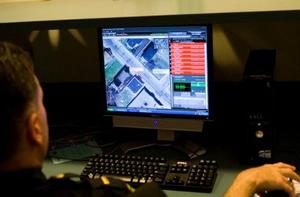Law enforcement technologyListening to the sound of bullets
ShotSpotter systems relies on a system of acoustic sensors to identify the location from which a shot has been fired; the alerts are immediately conveyed to police dispatchers, 911 operators, and sometimes to officers in the field via laptops in patrol cars; the system includes a computer program which displays a comprehensive bird’s-eye view of the area, marking the location of the incident with a red dot and indicating the time and number of rounds fired

Police officer deomonstrating the ShotSpotter system // Source: longislandpress.com
In 1992, East Palo Alto, a city of 24,000 on the San Francisco Peninsula, had the highest homicide rate per capita in the United States. Gun violence and celebratory gunfire plagued citizens and police.
Robert Showen, who worked at SRI International in Menlo Park, just two miles from East Palo Alto’s border, was worried. Showen, who specialized in acoustics and radio wave propagation, was not only worried – he wanted to do something about it. A University of California, Berkeley release reports that ShotSpotter, the company he built, has created the technology to do just that. Today, Showen’s shot spotting systems are deployed in more than seventy sites cities and towns across the United States and around the world.
This is how it works: When a gun is fired, it generates impulsive sound waves, a short blast of energy that creates the pop we hear. A network of acoustic ShotSpotter sensors — placed throughout urban communities — listens for the unique sound. When it is detected by multiple sensors, data are transmitted to a central server where the system’s software calculates the sound’s point of origin using differences in arrival time at the sensors. Each sensor also records an audio clip of the event.
Alerts are immediately conveyed to police dispatchers, 911 operators, and sometimes to officers in the field via laptops in patrol cars. The system includes a specialized computer program that company officials call Alert Console, which displays a comprehensive bird’s-eye view of the area, marking the location of the incident with a red dot and indicating the time and number of rounds fired. In the case of a drive-by shooting, when multiple shots are fired, the system will also calculate the direction and speed of the shooter.
The release reports that police credit the technology with reducing gunfire, catching suspects and saving lives. In 2009, the year it installed a ShotSpotter system, Richmond, California had forty-seven homicides. In 2010 that number fell to twenty-one.
